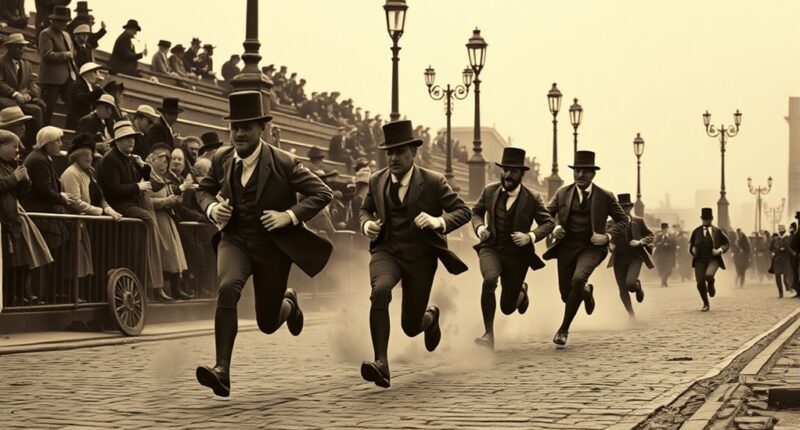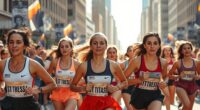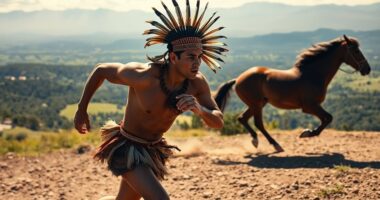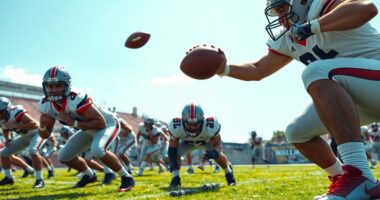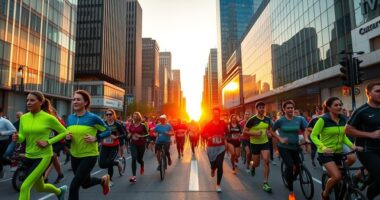Victorian races were wild spectacles full of eccentric costumes, unpredictable obstacles, and flamboyant personalities that helped shape modern running. These competitions combined entertainment with sport, featuring unusual track designs, bizarre rules, and theatrical events. Runners in flamboyant attire challenged norms, turning races into festive gatherings. If you want to discover how these quirky events laid the foundation for today’s organized athletics, there’s much more behind the fascinating history of Victorian racing.
Key Takeaways
- Victorian races began as informal public events, evolving into organized competitions with rules, tracks, and official regulations.
- Unique race features included eccentric costumes, obstacle courses, and unconventional track designs inspired by spectacle and entertainment.
- Betting customs and social norms heavily influenced race conditions, adding unpredictability and chaos to competitions.
- Spectator entertainment combined athletic contests with theatrical performances, fireworks, and themed pageants, making races lively social events.
- Eccentric personalities and flamboyant fashion choices by runners like Lord Cavendish contributed to the cultural impact and legacy of Victorian racing.
The Origins of Victorian Running Competitions
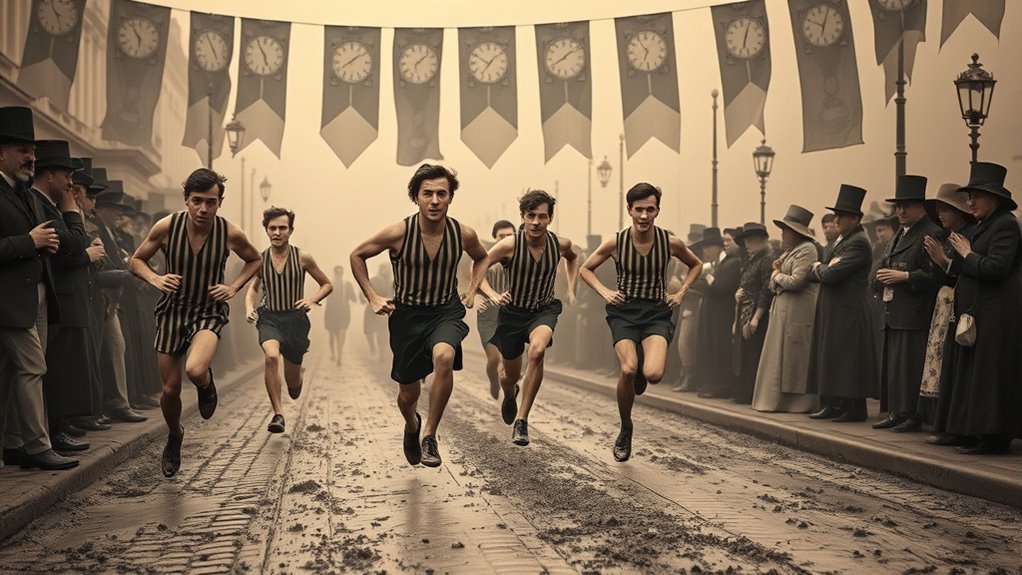
The origins of Victorian running competitions can be traced back to the early 19th century when public athletic events gained popularity across Britain. During this period, Victorian fashion heavily influenced running attire, often featuring long trousers, waistcoats, and hats, which made athletic wear look more formal than functional. Despite this, enthusiasts still organized races to showcase speed and endurance. These early competitions were often informal, held in parks or open fields, and attracted spectators from all social classes. As interest grew, so did the structure of the events, leading to more organized races with specific rules. Victorian runners prioritized appearance as much as performance, blending the era’s fashion sensibilities with athletic pursuits. Interestingly, some of these early athletic competitions included unconventional race formats that added a sense of novelty and spectacle to the events. This unique combination laid the groundwork for modern running competitions. Additionally, the cultural influences of the Victorian era played a role in shaping the aesthetic and organization of these early races, blending societal norms with emerging athletic interests. Moreover, the influence of emerging sports organizations helped formalize rules and standards for these races, contributing to the development of competitive athletics in Britain. The technological innovations of the time also impacted race timing and measurement, further professionalizing the sport.
Peculiar Rules and Regulations of 19th Century Races
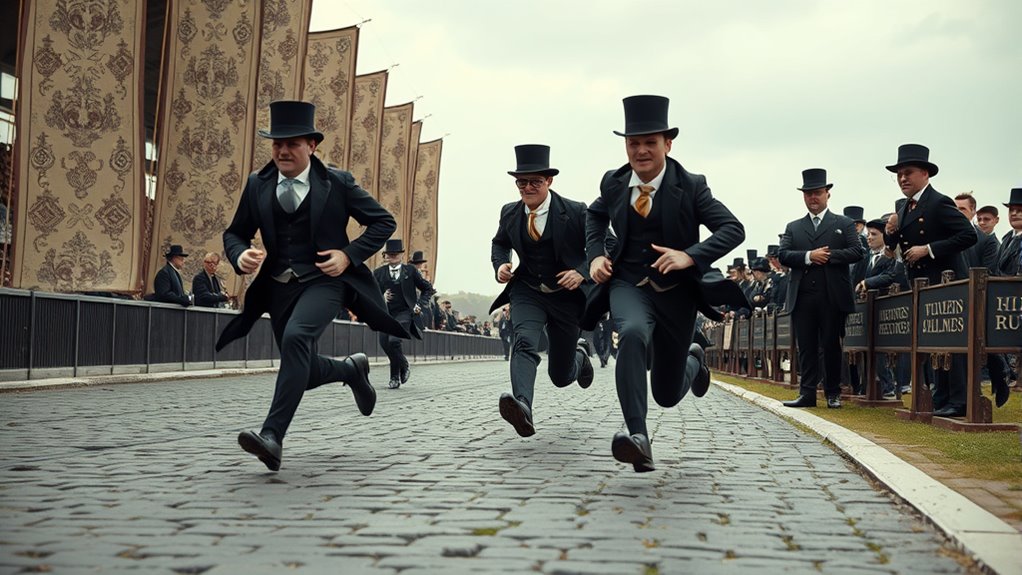
While many modern races emphasize standardized rules, 19th-century Victorian competitions often featured peculiar regulations that could seem odd today. Victorian fashion influenced race attire, with participants wearing tight-fitting clothes that restricted movement. Betting customs also shaped race rules; wagers often determined race conditions or outcomes. For example, some races required participants to wear specific uniforms or follow strict dress codes, sometimes including top hats or cravats. The rules could change based on betting interests, making races unpredictable. Additionally, race regulations were often influenced by social norms and gambling interests, leading to unpredictable and sometimes chaotic competitions. These eccentric regulations highlight how societal factors and gambling influences played a significant role in shaping Victorian racing events. Furthermore, the absence of formal oversight meant that race organization was often informal and subject to the whims of bettors and organizers. Moreover, the lack of standardized rules and regulations often resulted in disputes and confusion during races, reflecting the less formalized nature of these events.
The Great Victorian Racecourses and Their Quirks
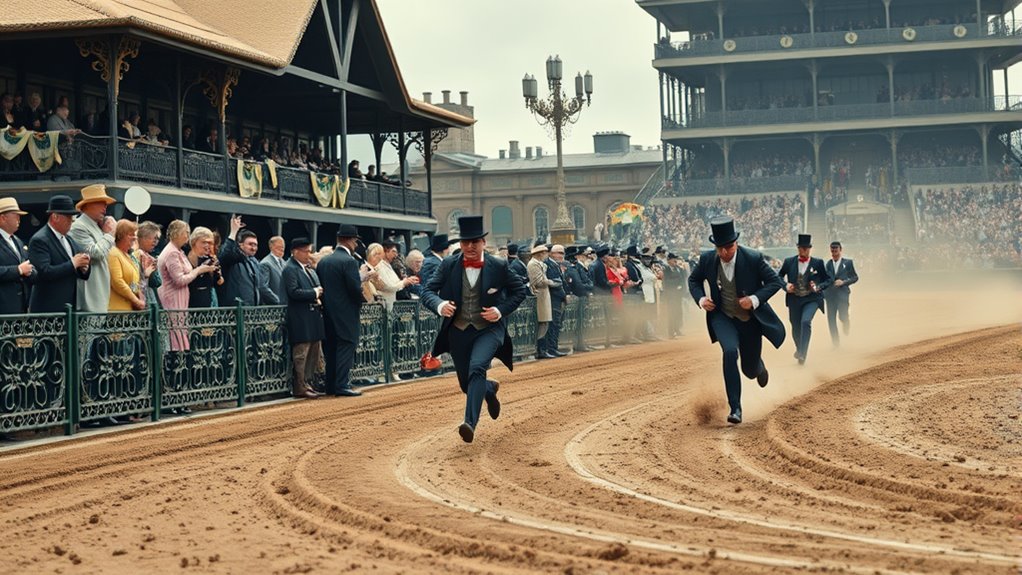
You’ll notice that Victorian racecourses featured unusual track designs that challenged both horses and jockeys. Some races had unique formats, like staggered starts or obstacle elements, making each event unpredictable. And the spectacle wasn’t just in the race itself; crowds enjoyed lively displays and entertainment that turned the races into grand social events. Many races incorporated creative track layouts that added an extra layer of excitement and complexity to the competitions, often requiring specialized riding skills from participants to navigate the diverse course features.
Elaborate Track Designs
Victorian racecourses often featured elaborate track designs that set them apart from modern tracks, showcasing both innovation and quirks. You might notice the horse drawn track, which was carefully crafted with intricate turns and uneven surfaces to challenge runners. Elevated platforms were used to give spectators better views, creating a layered experience of the race. These tracks often included sharp bends and sudden inclines, making races more unpredictable and exciting. Victorian engineers also experimented with track materials, blending dirt, gravel, and even cobblestones. Such complexity wasn’t just for spectacle—it tested a runner’s skill and endurance. These design choices reflect a fascination with spectacle and innovation, shaping the modern concept of racing. It’s a vivid reminder of how Victorian ingenuity pushed the boundaries of athletic entertainment.
Unusual Race Formats
Victorian racecourses often experimented with unconventional race formats that added excitement and unpredictability to the sport. One popular twist was combining races with costume contests, where runners dressed in elaborate outfits, turning events into lively spectacles. These costumes made the races more entertaining and attracted larger crowds. Some courses even held prize ceremonies immediately after quirky races, awarding medals for creativity or humor rather than just speed. These formats encouraged participation from all social classes and blurred the line between competition and entertainment. The mix of athleticism and spectacle kept spectators engaged, making Victorian races more than just sporting events—they became social gatherings full of surprises. These unusual formats helped shape modern racing by emphasizing entertainment alongside competition.
Spectator Spectacles
Ever wonder how Victorian racecourses transformed sporting events into elaborate spectacles? They didn’t just host races; they created grand crowd entertainment experiences. Spectator spectacles became the highlight, drawing crowds keen for more than just running. Races featured:
- Elaborate pyrotechnics and fireworks displays that lit up the sky during intervals.
- Performances by acrobats, dancers, and musicians to keep the crowd engaged.
- Themed days with costumes and pageants that turned spectators into part of the show.
These quirks made Victorian racecourses lively hubs of entertainment, far beyond simple athletic contests. The focus on crowd entertainment turned races into social events with a theatrical flair, establishing traditions that influence modern sporting spectacles today.
Unusual Challenges and Obstacles in Victorian Races

While the idea of a straightforward race might seem simple today, Victorian competitions often threw unexpected and bizarre obstacles in runners’ paths. You might find yourself dodging horse harnesses strewn across the track or maneuvering around tangled reins, adding a chaotic element to the race. Racers also had to contend with quirky challenges like running in cumbersome racing attire that limited movement or slowed progress. Sometimes, obstacles included uneven terrain or sudden barriers designed to test endurance and agility. These hurdles weren’t just for show—they made each race unpredictable and required quick thinking. Victorian race organizers thrived on creating strange, sometimes amusing challenges, making the races more than just about speed but about adaptability and resilience.
Notable Eccentric Runners and Their Stories
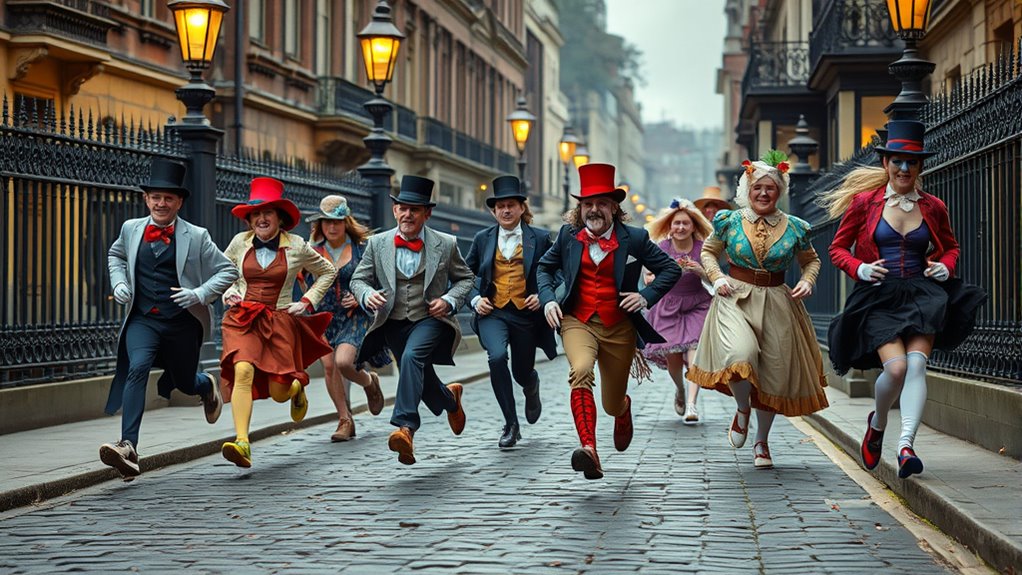
Among the most memorable figures of Victorian racing were runners whose eccentricities and daring personalities made them stand out. These individuals often defied conventions, blending Victorian fashion with their unconventional pursuits, fueling pedestrianism popularity. One such runner, Lord Frederick Cavendish, was known for his flamboyant attire and fearless stamina. Another, Miss Amelia Williams, combined daring outfits with relentless endurance, inspiring crowds. Their stories highlight how these eccentric runners captivated Victorian audiences and pushed the limits of racing. Their daring personalities and unique fashion choices made them legends of their time. Their influence extended beyond the track, shaping the culture of Victorian pedestrianism and challenging societal norms. These runners’ stories remain a testament to the eccentric spirit that fueled early modern running.
How Victorian Races Influenced Modern Sporting Events
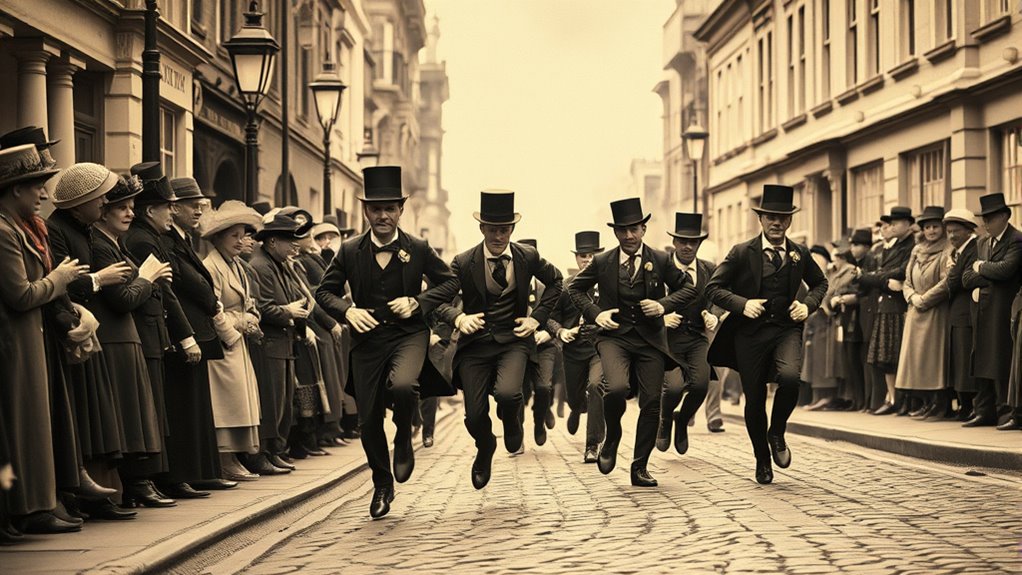
Victorian races didn’t just captivate audiences with their eccentric characters and daring feats; they also laid the groundwork for modern sporting events. These races drew inspiration from medieval jousting tournaments, emphasizing competition, skill, and spectacle. They also echoed ancient marathons, celebrating endurance and stamina. Victorian organizers borrowed the idea of structured, timed races to create standardized events, making competitions more accessible and exciting. The emphasis on spectacle, crowd engagement, and the celebration of physical prowess became hallmarks of modern sporting events like road races and athletic championships. By blending historical influences with entertainment, Victorian races transformed running from simple exercise into a popular, organized spectacle that continues to shape sports today.
The Role of Spectacle and Entertainment in Victorian Running
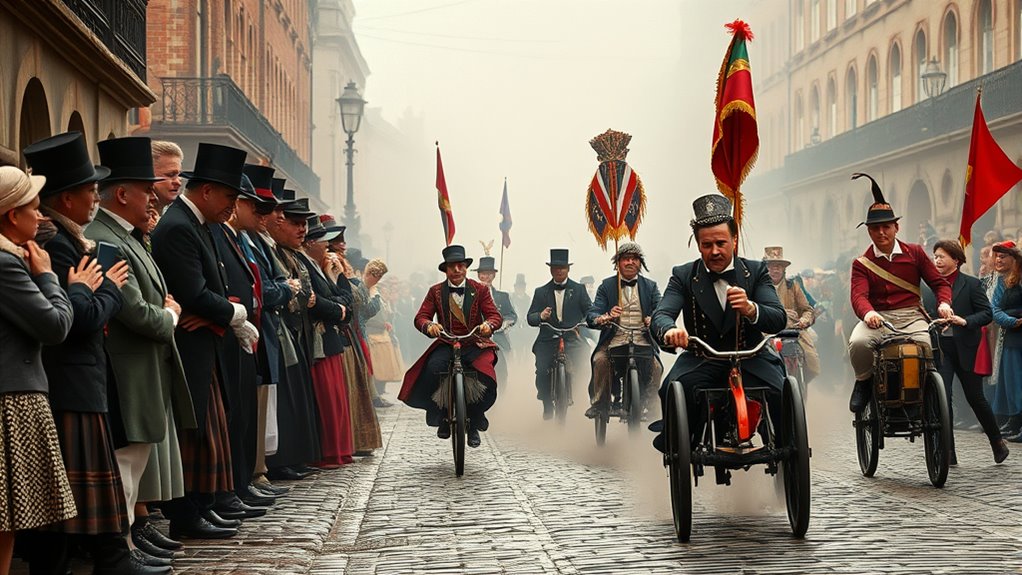
Spectacle and entertainment played a central role in Victorian running events, transforming them into public spectacles that drew large crowds. Spectators admired more than just the race; they were captivated by the display of Victorian fashion and elaborate racing attire. Races often featured flamboyant outfits, with runners and spectators alike dressing in colorful, fashionable clothing that added to the event’s theatrical atmosphere. The excitement extended beyond the finish line, with organizers incorporating music, cheers, and promotional displays to keep audiences engaged. These events became social gatherings, blending sport with entertainment to boost popularity.
- Elaborate Victorian fashion and racing attire heightened the visual appeal
- Organizers used music and spectacle to captivate crowds
- Races served as lively social and entertainment events
Strange Traditions and Rituals in 19th Century Races
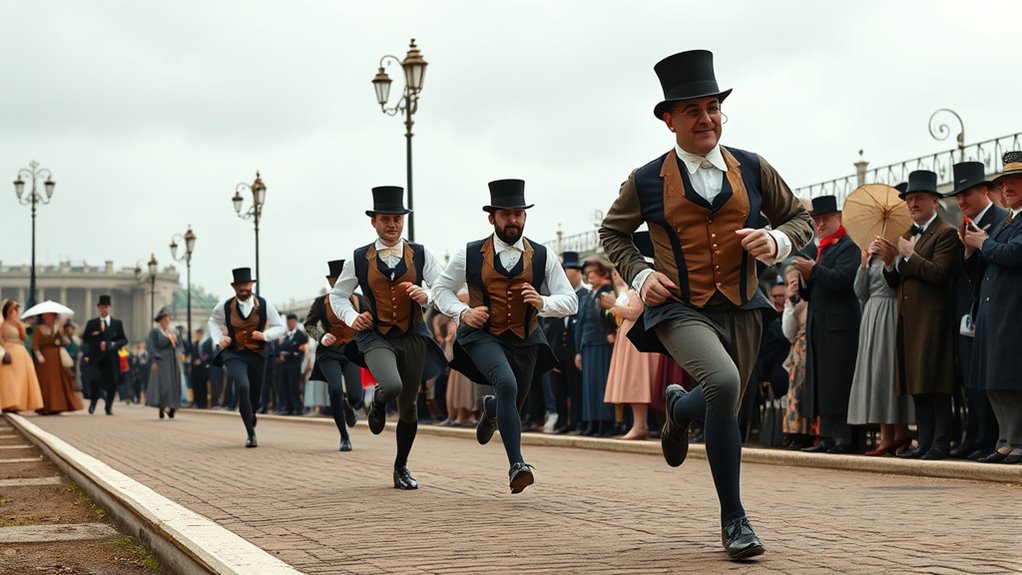
You might be surprised by the strange rituals and unusual race formats that filled Victorian races. Eccentric customs, like performers performing bizarre acts before races, added to the spectacle. These odd traditions reveal how race organizers sought to entertain and astonish spectators in unique ways.
Unusual Race Formats
Unusual race formats in the 19th century often featured strange traditions and rituals that baffled spectators and participants alike. These races went beyond simple footraces, incorporating unique rules and entertainment elements to attract crowds. For example, some events combined costume contests with racing, where participants dressed in eccentric outfits to impress judges and boost attendance. Betting schemes also played a major role, with organizers encouraging wagers on unpredictable outcomes, adding an element of chance. Additionally, races sometimes involved multiple stages or obstacle courses designed to challenge runners’ endurance and agility, making the events more spectacle than sport. These unconventional formats created a lively, unpredictable atmosphere that kept spectators engaged and contributed to the colorful history of Victorian racing.
Eccentric Rituals Performed
Eccentric rituals often added an extra layer of entertainment and mystique to Victorian races, enthralling spectators with their bizarre customs. Participants and spectators alike embraced Victorian fashion, dressing in elaborate costumes that often included top hats, parasols, and flowing dresses, creating a spectacle of eccentricity. Runners sometimes performed strange pre-race rituals, like bowing to the crowd or engaging in quirky warm-ups inspired by Victorian beliefs. Spectators indulged in Victorian cuisine, ardently sampling unusual treats that fueled the excitement. Some races featured bizarre ceremonies, such as blessing the track or performing odd dances before starting. These rituals turned races into theatrical events, blending sport with spectacle, and showcasing the Victorian obsession with tradition, oddity, and social display.
The Transition From Eccentric Races to Standardized Athletics
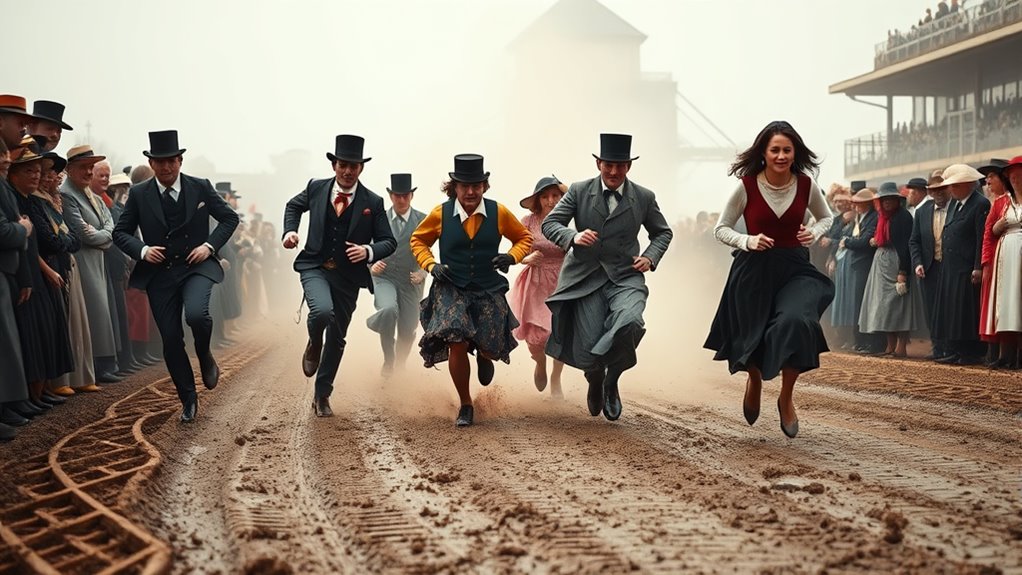
The shift from informal, local races to organized, standardized athletics marked a pivotal moment in the evolution of running. As Victorian society embraced more structured competitions, the fashion shifted from eccentric costumes to practical athletic wear, influencing modern sports attire. You’ll notice that Victorian food habits, once indulgent, gave way to healthier routines, paralleling the rise of formalized training. This progression also saw the creation of official rules, track measurements, and governing bodies, making races fairer and more competitive. By embracing consistency, racers moved beyond eccentric rituals.
- Formalized rules and regulations shaped race standards
- Victorian fashion transitioned toward functional athletic clothing
- The growth of clubs and governing bodies fostered widespread participation
Legacy of Victorian Innovations in Contemporary Running Culture
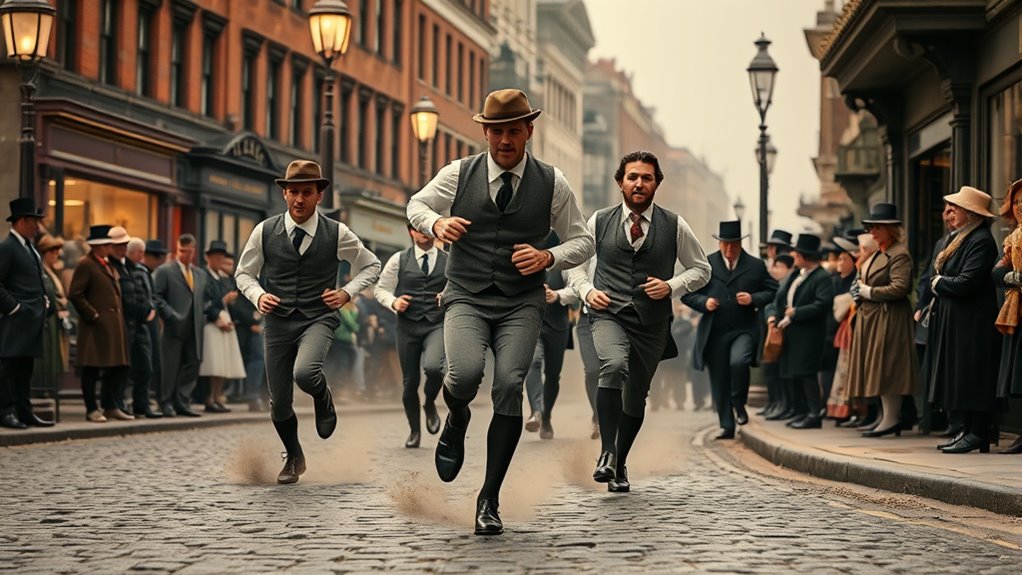
Victorian innovations continue to shape modern running culture in profound ways. You’ll notice Victorian fashion’s influence in the design of athletic wear, with streamlined, practical clothing echoing the era’s emphasis on function. This focus on performance laid the groundwork for modern sports apparel, making your runs more comfortable and efficient. Victorian cuisine also played a subtle role, as the period’s emphasis on healthy, hearty meals contributed to the development of sports nutrition. The Victorian era’s obsession with cleanliness and discipline fostered routines and training methods still used today. From the evolution of running shoes to the culture of endurance and training, Victorian innovations remain embedded in how you approach running, blending history with modern athleticism to create a seamless, enduring legacy.
Frequently Asked Questions
How Did Victorian Races Influence Today’s Marathon Events?
Victorian races introduced innovations like standardized distances and organized events, shaping modern marathon influence. You see these Victorian race innovations reflected today in the official 26.2-mile marathon standard, which originated from the 1908 London Olympics. Their emphasis on record-keeping and competitive spirit laid the groundwork for today’s organized, global marathon culture, inspiring runners to push limits and celebrate endurance, all rooted in those Victorian race traditions.
Were There Any Infamous Scandals or Controversies in Victorian Races?
Think of Victorian races as a stormy sea, where scandals often lurked beneath the surface. You might be surprised to learn about doping scandals and betting controversies that marred these events. Some runners used dubious substances, while betting rivalries fueled tension and corruption. These incidents cast shadows over the races, revealing the darker side of Victorian sport and reminding you that even in history’s earliest days, integrity was sometimes compromised.
Did Victorian Races Have International Competitors or Were They Local?
You’ll find that Victorian races mainly focused on local race traditions, with most competitors coming from nearby areas. However, as interest in athletics grew, some races began to see international participation, especially in larger events or exhibitions. While local races kept the community engaged, these early international competitors helped lay the groundwork for the global nature of modern running, blending local customs with broader athletic competition.
What Materials Were Used for Victorian Race Tracks and Equipment?
Victorian track materials were quite crude compared to today’s standards. You’ll find Victorian athletic gear made from simple, sturdy substances like canvas, leather, and wool, designed for durability. Victorian track surfaces often consisted of dirt or gravel, providing a basic but functional foundation. These humble materials laid the groundwork for modern tracks, yet they reflect the resourcefulness and roughness of Victorian athletic innovations, combining practicality with pioneering spirit.
How Did Victorian Societal Norms Shape Race Participation and Spectatorship?
You see, Victorian societal norms heavily influenced race participation and spectatorship. Gender roles restricted women from competing openly, often relegating them to side events or spectatorship. Class distinctions meant that upper-class individuals gained access to exclusive races, while lower classes faced barriers. These norms shaped who could participate and watch, reinforcing societal hierarchies. Understanding this helps you see how Victorian values molded the development of modern racing culture.
Conclusion
Ultimately, the Victorian races shape your understanding of modern running—through their quirks, through their rules, through their spectacle. They challenge your perception of sport, ignite your curiosity about history, and inspire your appreciation for innovation. By exploring these eccentric origins, you see how tradition and spectacle, chaos and order, innovation and entertainment intertwine. They remind you that every step forward carries echoes of the past, shaping what running becomes today.
